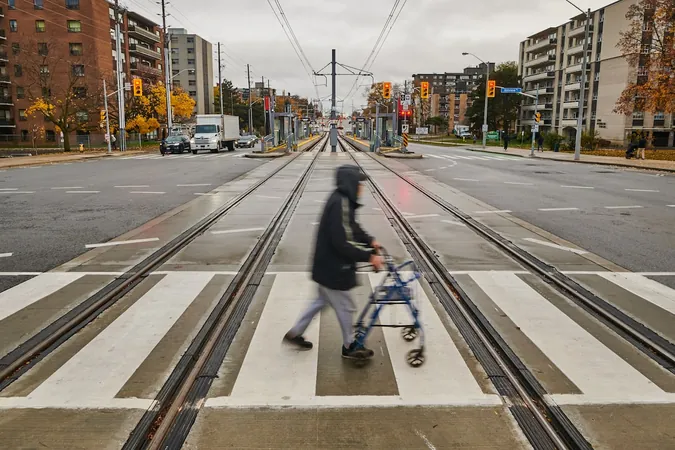
Canadian Transit Troubles: Why Do Major Projects Keep Failing?
2025-01-05
Author: Emma
Introduction
As Canadians eagerly anticipate the promised benefits of new transit systems, many feel like Charlie Brown with the football—constantly let down by missed deadlines and spiraling costs. Nowhere is this more palpable than in Toronto, where the $13-billion Eglinton Crosstown LRT project continues to face delays with no definitive opening date in sight.
The Global Context
These struggles are not confined to Canada alone; internationally, numerous expensive transit projects are similarly ensnared in delays and budget overruns, posing significant challenges to political leaders. As cities expand rapidly, clogged roadways intensify, highlighting the urgent need for alternatives to vehicular travel. Research consistently shows that simply building more roads does not alleviate congestion. Instead, expanding public transit options, which can efficiently move people, is critical. However, the construction of such systems must be reliable enough to encourage public support amidst the inevitable disruptions and costs associated with building new infrastructure.
Provincial Government Scrutiny
In Ontario, Premier Doug Ford's Progressive Conservative government has faced scrutiny, as no significant transit lines have opened in the Toronto region during their six-plus years in power. Recently, Phil Verster, the troubled CEO of the provincial transit agency Metrolinx, announced his resignation. His replacement indicates continuity in direction rather than a radical overhaul, leaving many to wonder what substantive changes could follow.
High Construction Costs
A concerning report from the University of Toronto's School of Cities highlights the fact that the cost of constructing rail transit in Canada exceeds the global average by over 60%. The researchers attributed these soaring expenses to overly elaborate designs and an overreliance on consultants. Importantly, they criticized Canadian officials for scaling back projects in response to budget inflation instead of addressing the root causes of skyrocketing construction costs. The researchers argued that if these costs could be curbed, it would free up resources for more ambitious projects that offer greater public benefit.
Successful Examples
While many Canadian transit projects are plagued with delays, some have managed to succeed. Vancouver's Canada Line SkyTrain was completed on time in 2009, a feat achieved largely due to the booming deadline for the 2010 Winter Olympics. Meanwhile, Montreal's Réseau express métropolitain opened with only minor hiccups, suggesting that not all initiatives are doomed to fail.
Common Challenges
However, the litany of delayed projects continues to grow, with several shared common elements. Experts have identified the intricacies of transit approvals and designs as being rife with political interference. Furthermore, the dearth of recent construction has led to a collective knowledge gap on the part of governments regarding how to effectively manage transit projects, leading to costly missteps.
Historical Context
Historically, Toronto's subway systems were constructed using simpler methods such as 'cut and cover,' which allowed for rapid expansion without the extensive approvals required today. Now, the complexity of modern transit projects demands a more careful approach that often extends timelines and increases costs.
Shift to Public-Private Partnerships
Another significant trend has been the shift toward public-private partnerships (P3s) for transit project delivery. This model was once considered innovative, promising to streamline funding and risk management. However, as seen in Ottawa's troubled light-rail initiative, P3s have recently fallen out of favor, leading to adversarial relationships between cities and contractors and a surge in litigation.
Reevaluating Approaches
As governments reflect on past shortcomings, transit experts are calling for a reevaluation of the P3 approach. This shift is already underway, with some new projects like the Ontario Line being broken into smaller, more manageable contracts that could mitigate risk and enhance collaboration between stakeholders.
Rising Costs
Despite these adjustments, costs continue to rise dramatically. The projected cost of the Ontario Line ballooned from an initial estimate of $11 billion in 2019 to a staggering $27 billion in 2024. This persistent inflation alarms taxpayers and raises fears about the feasibility of future projects.
Ongoing Challenges
Meanwhile, in cities across Canada, plans are struggling to maintain momentum. Calgary's Green Line has been in limbo after funding disagreements curtailed its scope, and residents remain skeptical about when improvements will finally come to fruition. Toronto's Eglinton Crosstown LRT is emblematic of broader systemic issues; once slated for completion in 2020, it is now engulfed in a legal quagmire and without a clear operational date.
Political Complications
Politicians often complicate matters by micromanaging transit designs, driven by local concerns, and failing to recognize the true cost implications. You’d be surprised by how many choices made with good intentions have ended up resulting in dramatic cost increases and construction challenges.
Conclusion
Ultimately, the path forward for Canadian transit systems must involve learning from the past, adopting efficient project management strategies, and establishing stable partnerships to ensure public transit becomes a viable and effective solution for the challenges urban centers face today. It's time for Canada to embrace innovation, transparency, and accountability in its transit initiatives or risk repeating the same mistakes. As frustrated commuters await their much-anticipated transit options, one question remains: When will the next project finally deliver?



 Brasil (PT)
Brasil (PT)
 Canada (EN)
Canada (EN)
 Chile (ES)
Chile (ES)
 Česko (CS)
Česko (CS)
 대한민국 (KO)
대한민국 (KO)
 España (ES)
España (ES)
 France (FR)
France (FR)
 Hong Kong (EN)
Hong Kong (EN)
 Italia (IT)
Italia (IT)
 日本 (JA)
日本 (JA)
 Magyarország (HU)
Magyarország (HU)
 Norge (NO)
Norge (NO)
 Polska (PL)
Polska (PL)
 Schweiz (DE)
Schweiz (DE)
 Singapore (EN)
Singapore (EN)
 Sverige (SV)
Sverige (SV)
 Suomi (FI)
Suomi (FI)
 Türkiye (TR)
Türkiye (TR)
 الإمارات العربية المتحدة (AR)
الإمارات العربية المتحدة (AR)